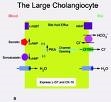| Home > 4. Drinking Sodium Bicarbonate Solution > 4.2 Secretion in Vivo by Rat Distal Tubules |
 Previous Next Previous Next  |
|
|
|
To examine in vivo the separate effects on distal tubule JtCO2, of dietary chloride restriction, bicarbonate loading, and changes in luminal chloride concentration.
 Chloride ChlorideBecause net potassium secretion comprises secretory and absorptive components, we sought to evaluate the effects of chloride and barium on unidirectional potassium fluxes in the renal distal tubule. In vivo microperfusion methods were used in anesthetized Sprague-Dawley rats. [1]
It promotes binding to inhibitory GAMMA- AMINOBUTYRIC ACID subtype receptors, and modulates chloride currents through receptor channels. It also inhibits glutamate induced depolarizations. [2]
We investigated the renal expression of Opn in normal, ethylene glycol (EG), and EG + ammonium chloride- treated rats. Male Sprague-Dawley rats were divided into three groups. [3]
 Bicarbonate Testing in Rats Bicarbonate Testing in RatsSecretion of bicarbonate by rat distal tubules in vivo. Modulation by overnight fasting. [9]
Stationary microperfusion was performed with double-barrelled pipettes blocking droplets of 25 mM bicarbonate Ringer solution with castor oil in the tubule lumen. These fluid droplets were punctured with pH-sensitive microelectrodes and the pH was followed from the initial alkaline value (approximately pH 8) to the stationary level. [10]
Although they did not note it, the gastric delivery of these agents caused them to be exposed to gastric acid followed by exposure to the hepatic bile, the pancreatic bicarbonate, and the pancreatic digestive enzymes. These exposures to strong acid, moderate base, and hydrolytic enzymes alter the chemical nature of the compounds used in their investigation and their effects on the gastrointestinal tract and its contents.[11]
 Increased Dosage Increased Dosage Nonetheless, some qualitative differences exist between cells osmotically stressed by increasing the osmolality of the incubation medium and decreasing intracellular osmolality. The results support a role for taurine in the regulation of osmotic balance in the neonatal cardiomyocyte. [19]
Trimethoprim statistically increased renal sodium excretion when compared with control animals. The absolute sodium excretion rates that were used to calculate these values were: for the control animals in periods I and II, 1450 nmol/min (CI, 800 to 2100 nmol/min) and 2592 nmol/min (CI, 1703 to 3481 nmol/min); for the trimethoprim animals, 1491 nmol/min (CI, 956 to 2026 nmol/min) and 3824 nmol/min (CI, 2627 to 5021 nmol/min).[20]
Increased acidification in control animals was mediated by increased distal tubule H+ secretion (23.7+/-2.2 vs. [21]
 Reabsorption ReabsorptionTo examine unidirectional components of net bicarbonate reabsorption during chronic MA, we measured distal tubule unidirectional bicarbonate secretion (Jsec) and reabsorption (Jreab), as well as the inhibitor sensitivity of Jreab. In control, 2-day, and 7- day alkalosis , Jsec was similar. [33]
An ostensible inhibitory effect on sodium reabsorption in the distal tubule was not unequivocally established. [34]
 Effected Cells Effected CellsNo punctate SF fluorescence was seen in proximal tubule cell cytoplasm. Probenecid reduced proximal tubule cell SF fluorescence to 0.64 +/- 0.40 (n = 64) times that of plasma. [35]
Clusterin (sulfated glycoprotein-2) is a heterodimeric glycoprotein synthesized and secreted by rat Sertoli cells. An antigenically similar form is synthesized and secreted by the epididymis. [36]
For experiments, tubules were transferred to a perfusion chamber that contained coverslips prepared with the biological adhesive Cell-Tak (Becton Dickinson). The temperature of the chamber was maintained at 37 ? 0.5?C by an electronic feedback circuit. [37]
|
|
|
|

